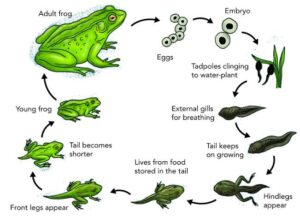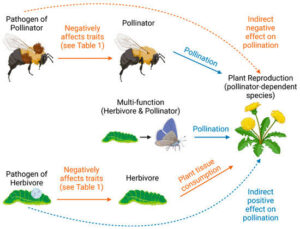Back to: ZOOLOGY 300 Level
WELCOME TO CLASS!
You’re doing excellently, and I’m proud of the energy you’re bringing to your learning. Today’s lesson will take us into the life processes that keep amphibians like frogs and salamanders going strong—Reproduction, Metamorphosis, and Respiration.
Whether you’ve heard the croaking of frogs after a heavy rain in Calabar or seen tadpoles swimming in puddles during the rainy season in Benin, you’ve already witnessed parts of these processes in real life. Let’s go deeper into how amphibians grow, breathe, and multiply.
Reproduction, Metamorphosis, Respiration
Reproduction
Amphibians generally reproduce sexually, meaning they need both male and female gametes—sperm and eggs—to create new life. Most species reproduce externally, while a few have internal fertilisation.

External Fertilisation
- In most frogs and toads, the female lays eggs in water, and the male releases sperm over them to fertilise them externally.
- This usually happens in calm, shallow water, such as swamps, ponds, and puddles.
- In Nigeria, rainy season puddles are breeding grounds for many local frog species.
Internal Fertilisation
- Seen in some salamanders and caecilians.
- The male deposits sperm inside the female’s body, and fertilisation happens internally.
Most amphibians lay hundreds or thousands of eggs because many don’t survive to adulthood due to predators or environmental factors.
Some species even show parental care. For example, male African bullfrogs may guard their tadpoles and even dig channels to help them reach better water sources.

Metamorphosis
This is one of the most striking features of amphibians. It’s the process through which they undergo a dramatic body transformation from larva to adult.
Stages of Amphibian Metamorphosis
- Egg – Laid in water.
- Larva (Tadpole) – Hatches with gills, a tail, and no legs; it looks like a fish and breathes underwater.
- Metamorphic Changes – Legs develop, tail shrinks, gills are replaced by lungs.
- Adult – Fully formed with lungs and limbs, capable of living on land and in water.
This process allows amphibians to live double lives—starting in water and transitioning to life on land.
In Nigeria, children often collect tadpoles from rain-filled potholes, watching as they slowly grow legs and transform into tiny frogs. It’s science happening right before our eyes!
Respiration
Amphibians have multiple methods of breathing, depending on their life stage and environment.
- Gills – Used by larvae (like tadpoles) for underwater respiration.
- Lungs – Adults develop simple sac-like lungs. These are not very efficient, so amphibians supplement with other methods.
- Cutaneous Respiration – This is breathing through the skin. Amphibian skin is thin and moist, rich in blood vessels, allowing oxygen and carbon dioxide to pass directly through.

Some species, especially in moist environments, rely heavily on skin breathing. That’s why frogs need to stay wet—if their skin dries out, they can’t breathe properly.
- Buccopharyngeal Respiration – This involves gas exchange through the lining of the mouth and throat. It’s more like a backup system.
Together, these methods allow amphibians to survive both in water and on land—a critical adaptation for their amphibious lifestyle.
Summary
- Amphibians reproduce mostly by external fertilisation in water; some show parental care.
- Metamorphosis transforms larvae with gills and tails into adults with lungs and limbs.
- Amphibians breathe through gills (as larvae), lungs, skin, and their mouth lining as adults.
Evaluation
- What is the main difference between external and internal fertilisation in amphibians?
- List the four main stages of amphibian metamorphosis.
- Why do amphibians lay so many eggs?
- Explain cutaneous respiration and why it is important.
- What are two respiratory methods used by adult amphibians?
You’ve just explored how amphibians are born, grow, and breathe—each stage a masterpiece of evolution. Keep nurturing your love for Zoology, because your knowledge is becoming as deep as the rivers where these creatures live. See you in the next class!
